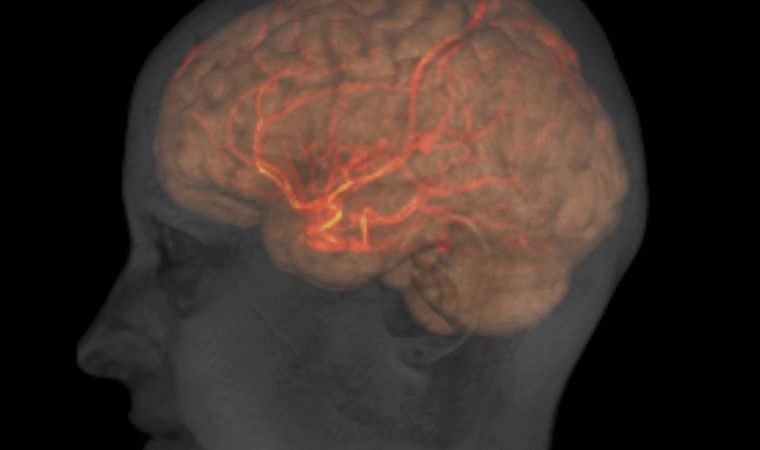
How different are women’s and men’s brains? A Q&A with Prof Gina Rippon
We spent a fascinating hour talking to Prof Gina Rippon about what neuroscience tells us about sex and gender.
Image: Patrick Hales, UCL (CC by 4.0)
Hello everyone. I am Emeritus Professor of Cognitive  Neuroimaging at the Aston Brain Centre, Aston University, Birmingham. I’m now semi-retired, but continue to supervise PhD students UK, and try and keep my hand in on the brain imaging front. I’ve been at Aston since 2000 and was at the University of Warwick before then. You can find out more here: https://en.wikipedia.org/wiki/Gina_Rippon.
Neuroimaging at the Aston Brain Centre, Aston University, Birmingham. I’m now semi-retired, but continue to supervise PhD students UK, and try and keep my hand in on the brain imaging front. I’ve been at Aston since 2000 and was at the University of Warwick before then. You can find out more here: https://en.wikipedia.org/wiki/Gina_Rippon.
My ‘day’ job has involved using the state-of-the-art brain imaging techniques that we have at Aston. I’m interested how the brain processes what is going on around it, and what happens when this goes wrong. Currently my research focus is on Autism Spectrum Disorders, trying to measure ‘misfiring’ feedback loops in ASD brains. I am also involved in research investigating girls on the autistic spectrum and whether they present a different biological and behavioural profile to the classic profile associated with boys on the spectrum.
I am heavily involved in critical neuroscience, commenting on the use of neuroscience techniques to explore brain-changing social processes such as gender stereotyping and stereotype threat. I’m against the idea that there are two sorts of ‘hardwired’ brains’, male and female, and that this explains all kinds of gender gaps and gender inequalities. There are differences in brains from men and brains from women, but they come from the lives they have lived not the sex of their owners!
I am an outspoken critic of the ’neurotrash’ (known as the “Neurotrash Warrior”), the populist misuse of neuroscience research to misrepresent our understanding of the brain and, most particularly, to prop up outdated stereotypes.
PSG A: Thanks for being here with us. What an exciting life you live. You’ve gotten me all curious now about the imaging of the brain whilst breastfeeding – I wonder what the connections look like over a breastfeeding duration. You done by any chance know if someone is currently investigating
PSG B: What a great thought!
Gina: Yes – I’m pretty sure that there is some work on this. Certainly there is on looking at the brain of mothers with their babies (and also with both mothers and babies).
Q: From reading your articles, I have understood that structurally, there are some noticeable differences between male and female brains, but that functionally, the two groups show more variation within themselves than difference with the other group.
For those of us that are new to neuroscience (!), could you tell us a little about what is meant by structure and function?
Gina: Structure refers to the hardware of the brain and function is what it does – what skills etc it supports. The main problem with human brains is that almost every structure does more than one thing so you can’t necessarily tell how useful having a bigger amygdala (say) means to how you will behave.
Q: Your research about ASD is interesting. When I studied psychology, autism was described as the ‘extreme male brain’. Given what you’re researching, is there something different about male brains or genetics that pre-disposes them to ASD? There certainly seem to be more males diagnosed with it.
Gina: That is Simon Baron-Cohen’s theory. There are more males than females diagnosed with autism (although that may say something about the diagnostic process). He suggests that males are systemisers as opposed to empathisers and that ASD individuals are extreme systemisers.
PSG E: Is your theory that the traits of ASD are learnt at a young age?
Gina: I think ASD is a genetically determined brain-based problem. But it is much more to do with how the brain processes information differently in ASD individuals which cause them to experience the world in a different way. A mis-wired brain can be overwhelmed by its world.
PSG F: Do you have a theory as to why autism presents differently in boys than girls – is it two separate things, or are they different presentations down to the nurture idea – girls and boys being socialised in a different way resulting in different expressions of autism?
Gina: It does appear to be associated with socialisation. Girls are encouraged more to acquire social skills/learn the right social scripts. It is suggested that ASD girls therefore ‘fly under the diagnostic radar’ for longer than boys because they appear to have normal social skills. Only when life gets more complicated e.g. on transition to secondary school – do the present with problems.
PSG F: Is there a difference in numbers of boys and girls with autism at the more extreme end of the autistic spectrum – I am thinking about children who would be unable to mask their autism and whether in the more severe cases the numbers of boys and girls are similar? Or is there still a sex difference – and if so why would that be?
Gina: Yes – the more impaired the children the lower the male/ female ratio.
Q: Could you tell us a bit about neuroplasticity please? I am guessing that accounts for many of the differences we might see between male and female brains and the nurture over nature element?
Gina: Absolutely. We have realised in the last 30 years or so that our brains are changing as a result of the experiences we have (and attitudes we encounter), all of our lives (not just when we are very young), and that this will be reflected in our brains. This includes experiences with stereotypes for example.
PSG E: So we could ‘train’ our brains? If society encourages men and women to be interested in different things then they naturally end up better at those things? Self-fulfilling our society’s ideas about what men and women’s brains are good at!
Gina: Spatial cognition is a great case in point. We know that experience, from toys to video games to target -type sports, improves spatial cognition. And guess who tend to be involved in these experiences more?!
PSG G: How late in life do these changes occur and how frequent are they? Do they slow down as we age?
Gina: It looks as though they carry on throughout life. May get slower and rope in more parts of the brain to help, but we still keep chugging along!
PSG A: Gina does the brain play any role in passing on generational trauma, like in the case of post traumatic slavery syndrome (I think that’s what’s it’s called) amongst African Americans?
Gina: We now know there are so-called epigenetic processes that can switch genes on and off as a function of what is going on. And this can be passed on e.g the children of people who have suffered in famine are much more likely to have obesity problems.
PSG B: I’m very interested in this!
PSG A: Sorry about my basic question – is epigenetics connected to the brain? I assume the switching of genes on and off is in our DNA, right?
Gina: The process involves the DNA. Doesn’t change it but can stop if being expressed. It’s early days yet in this research but it appears to affect a wide range of physiological processes.
Q: Why do you think that popular media is so willing to believe that the male and female brains are so different from each other from looking at brain scans? Is it their way of finding “evidence” to back up their inherent stereotyping, do you think?
PSG B: It just confuses me. What is a female trait and a male trait anyway??!!
Gina: Popular media love our ‘seductive’ brain images! A story about map-reading vs multitasking makes much better copy than ‘men aren’t that different from women!
Q: How do hormones impact on brain function? As men and women have different hormones, does this have an effect on how the brain develops?
Gina: Yes indeed. There is a theory that our brains are fully organised by our different hormones (in the same way our bodies are). But it is becoming clear that the effects of hormones are very much entangled with what is going on outside us as well (e.g men having different levels of testosterone depending on who is the primary caregiver).
PSG F: That is really interesting – about the testosterone and primary caregiver – I didn’t know that hormones respond to ‘nurture’ as well as nature.
Gina: Yes indeed. You should have a look at Cordelia Fine’s book Testosterone Rex.
PSG H: In what way? If the father is the primary care giver does that result in boys with more or less testosterone?
Gina: No, it is the testosterone levels in the fathers that vary.
PSG G: Men have different levels of testosterone depending on primary care giver??!! Do you have any links please So I can read about it?
PSG I: I’m desperate to know what the pattern is now! Do men’s levels of testosterone change when they are primary caregiver/not? Or depending on who was their ordinary caregiver?
Gina: Going to refer you all to Testosterone Rex!
PSG J: I assumed that male caregivers were likely to have lower levels of testosterone than, erm, matadors or cage fighters?!
Gina: Erm….. I’ll pass on that. TRex for you too.
PSG K: Just so I’m clear – if a dad becomes primary caregiver, his testosterone reduces?
Gina: It’s a bit more ‘nuanced’ than that as T levels vary throughout the day and in different circumstances. But overall, T levels are reduced if a male is the primary caregiver.
Q: Caitlyn Jenner referred to the idea of a female brain as fact, if I remember correctly, during her interview with Piers Morgan on ITV recently – what do you think of this?
Gina: Yes – she said it several times. It is indeed the main feeling expressed by transsgender individuals, they have a female brain in a male body or vice versa. Or that they have been born in the wrong box. It concerns me greatly – it is the effect of an unshakable belief that there is a direct link between biological sex and social gender. Which is, of course, the mantra of 18th century (male) neurologists that still gets muttered!
Q: Gina What is your “favourite” piece of neurotrash and why?
Gina: There’s a great one recently where there was media coverage of a study sex differences in male/female aggression. it was actually on mice. By the time it got passed down the media chain, it had morphed into a study with men and women and was heavily illustrated with Shades of Grey images.
Q: A friend cites studies from countries like Sweden and Norway where men and women are treated the most equally and given the most equal opportunities. He says the women will still mostly choose caring professions like nursing and men will still on the whole choose stereotypically ‘manly’ professions, and says that proves that ‘women’s’ and ‘men’s’ jobs are more to do with biology than social construct.
Is there any evidence for this? I think it is Simon baron Cohen’s work that my friend cites.
Gina: I don’t know much about that I’m afraid but shall follow it up! Are there salary differences in those kind of professions, by any chance?
I think there is a widespread belief that sex differences in career choice are to do with the People vs Things dimension.
PSG N: Ha ha! Yes of course there are salary difference – the ‘male’ jobs are paid more.
PSG A: I also wonder if their career choice has anything to do with negotiating the toll of motherhood.
PSG F: Also how their school system works – I know in the UK (and US I assume?) girls tend to be encouraged out of STEM subjects by the general assumption that boys are better at it – is that also an issue.
Gina: Yes absolutely. And the sad thing is that girls believe it of themselves.
Q: Can you tell us how gender stereotyping and gender threat change the brain?
PSG I: Could you explanation what gender threat is please?
Gina: Stereotype threat is when you belong to a group (females, say) where there is a stereotype that that group underperforms at whatever task you are being asked to carry out (maths, say). This has been shown to affect both behaviour (you do worse than you should do) and the brain (less effective areas are recruited to solve the problems). Classic self-fulfilling prophecy.
PSG B: Does it happen the other way around too. You are male and therefore you’ll be brilliant at maths…?
PSG I: Stereotype bolstering? Interesting!
Gina: Yes – it does work that way too.
Q: So you are looking at differences between male and female, and differences between ASD and (I believe the term is ) neurotypical brains. Are there any observable differences in either case? Isn’t everyone on a curve?
Gina: My brain imaging work is comparing ASD individuals with ‘neurotypicals’ (not looking at sex differences at the moment). And yes, they are different.
PSG C: Gina, can you tell us about some of the differences that can be seen?
Gina: It looks as if the ASD brain is unable to make the world as predictable as is usually the case. Can’t process quite basic sensory information so the world quickly becomes ‘noisy’ and distressing.
PSG O: I assumed that diagnoses were based on observational behaviour
Gina: Yes. All ASD diagnoses are currently based on observational processes.
PSG O: But from what you are seeing, brain imaging shows exaggerated (?) responses to external stimuli?
Gina: Yes, basically. There’s a great little (literally) book by Uta Frith: Autism: A Very Short Introduction.
PSG O: Do we know anything about cause?
Gina: I wish! It looks like a problem in connectivity within the brain – the differences are showing up in the feedback loops. Can be both over- and under-active.
Q: I have a general ASD question – is it possible to ‘train’ unused or underused parts of the brain to learn social skills and other skills which other parts of the brain aren’t doing properly?
Gina: It is certainly possible to train social skills but I don’t think it involves ‘unused’ parts of the brain – just brings the relevant ones above threshold. There is evidence that this can work at lower levels e.g with blind or deaf people.
Inspired? Want to find out more about sex and gender? Why not check out some of our other Q&A sessions:
- Stereotypes: breaking the rules with Rebecca Asher
- Being Boys, Being Girls with Carrie Paechter.
Or if you want to get involved in some real research, come and join the Let Toys Be Toys Parenting Science Gang.


